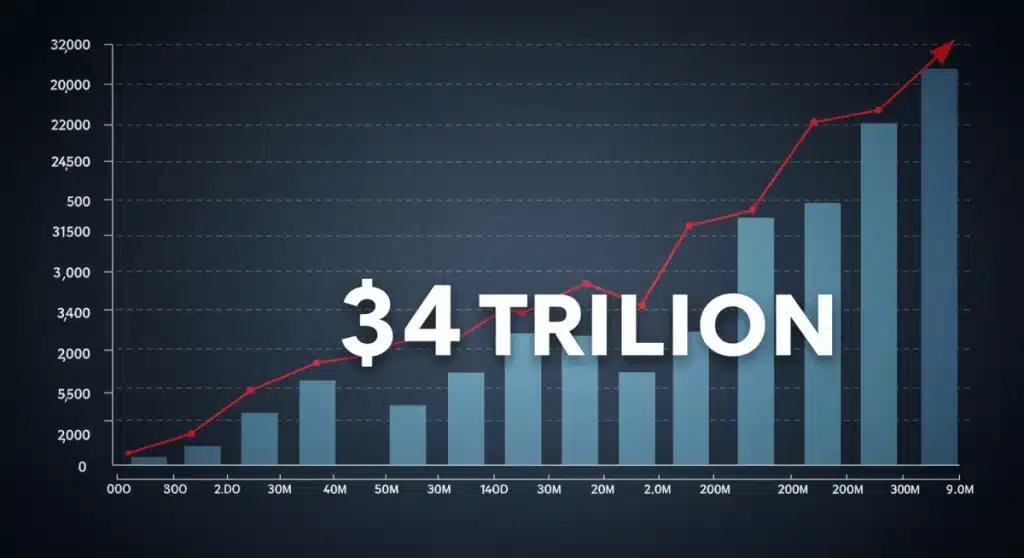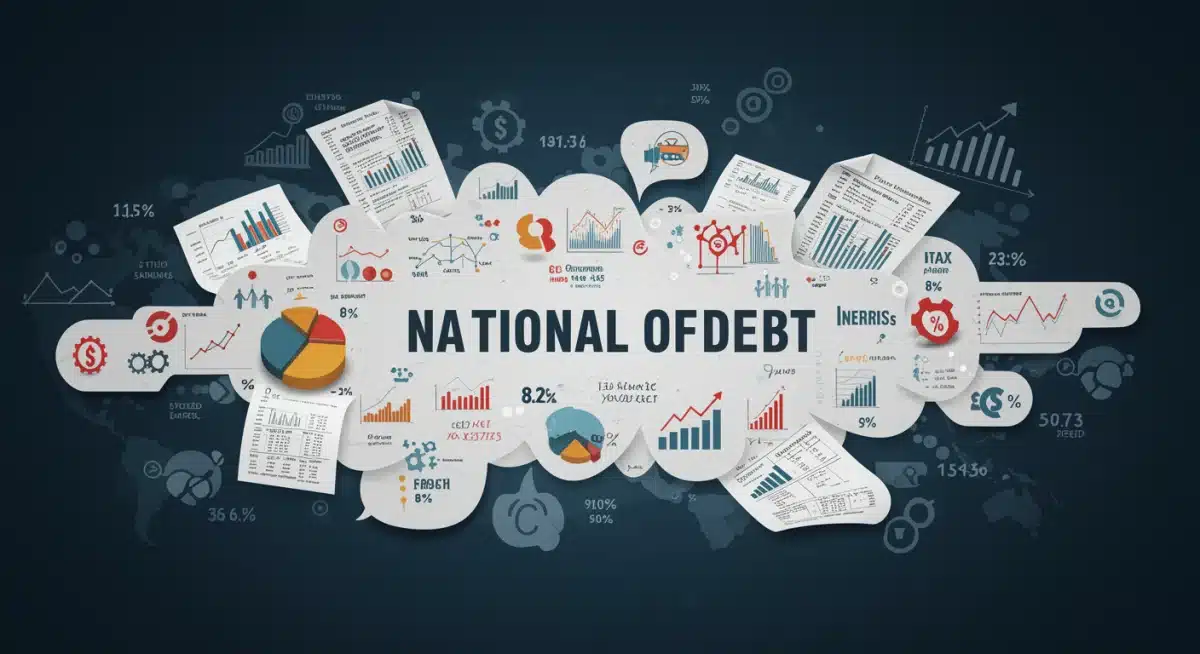US National Debt Surpasses $34 Trillion: What You Need to Know

The U.S. national debt officially surpassed an unprecedented $34 trillion in January 2024, marking a critical milestone for the nation’s fiscal health and economic future. This development raises significant questions about sustained government spending, interest rate impacts, and long-term economic stability.
Did You Know that the U.S. national debt surpassed $34 trillion in January 2024? This staggering figure marks a significant and concerning milestone, prompting immediate questions about the nation’s financial trajectory and the potential impact on every American. This breaking news highlights critical fiscal challenges requiring urgent attention and understanding.
The $34 Trillion Milestone: A Closer Look
The U.S. national debt officially sailed past the $34 trillion mark in early January 2024, according to data from the Treasury Department. This threshold was reached much faster than anticipated by many economic forecasters, reflecting a confluence of factors including aggressive government spending, persistent budget deficits, and rising interest rates.
This new record illuminates the ongoing fiscal strain on the federal government. The debt ceiling, which was suspended in early 2023, is set to be reinstated in 2025, setting the stage for potential political battles over future spending and borrowing authority. The sheer scale of this debt raises serious questions about the sustainability of current fiscal policies and their long-term economic consequences.
Understanding the Debt’s Composition
The national debt is not a monolithic entity; it comprises various components. It includes debt held by the public, such as Treasury securities bought by individuals, corporations, and foreign governments, as well as intragovernmental holdings, which represent debt owed by one part of the government to another.
- Public Debt: This portion accounts for the majority of the national debt and is subject to market forces and investor confidence.
- Intragovernmental Holdings: Primarily consists of government trust funds, like Social Security and Medicare, which invest their surpluses in Treasury securities.
- Recent Growth Drivers: Significant spending related to COVID-19 relief, infrastructure investments, and increased defense budgets have accelerated debt accumulation.
Factors Contributing to the Surging Debt
Several key factors have converged to push the U.S. national debt to its current unprecedented level. Understanding these drivers is crucial for comprehending the complexity of the situation and for formulating potential solutions. The pace of debt accumulation has intensified in recent years, propelled by both economic shocks and policy decisions.
For instance, the fiscal responses to the COVID-19 pandemic introduced trillions of dollars in emergency spending, greatly expanding the national balance sheet. While these measures were deemed necessary to stabilize the economy, their long-term fiscal implications are now becoming increasingly apparent. This period also saw a significant reduction in tax revenues due to economic slowdowns, further widening the budget deficit.
Government Spending and Deficits
Persistent budget deficits are a primary driver of the growing national debt. For decades, the federal government has spent more than it collects in taxes, necessitating borrowing to cover the difference. This trend has been exacerbated by major legislative actions and recurring economic downturns.
- Pandemic Relief Packages: Trillions were allocated for stimulus checks, unemployment benefits, and business support programs.
- Increased Defense Spending: Ongoing geopolitical challenges and modernization efforts contribute to substantial defense outlays.
- Entitlement Programs: Social Security and Medicare costs continue to rise as the population ages, placing increasing pressure on the federal budget.
Impact of Rising Interest Rates on Debt Servicing
The Federal Reserve’s aggressive interest rate hikes, aimed at combating inflation, have had a direct and significant impact on the cost of servicing the national debt. As interest rates rise, the government must pay more to borrow money and to refinance existing debt, which adds billions to annual expenditures.
This increased cost of borrowing diverts funds that could otherwise be used for other critical public services or investments. The Congressional Budget Office (CBO) has repeatedly warned about the escalating net interest payments, projecting them to become one of the largest federal outlays in the coming decade. This creates a challenging feedback loop where more borrowing leads to higher interest payments, which in turn necessitates more borrowing.
Future Fiscal Challenges
The trajectory of interest rates will play a pivotal role in the future growth of the national debt. Even a slight increase in average interest rates can translate into hundreds of billions of dollars in additional annual interest payments, further straining the federal budget. Policymakers face the difficult task of balancing fiscal responsibility with economic growth and social needs.
The challenge is compounded by the fact that a substantial portion of the national debt needs to be rolled over or refinanced regularly. When this occurs in a high-interest-rate environment, the cost of debt servicing can quickly become unmanageable. This situation underscores the urgency of addressing the underlying structural deficits.

Economic Implications for the American Public
The ballooning national debt carries a range of potential economic implications for the American public, extending beyond abstract financial figures. These impacts can manifest in various ways, from slower economic growth to increased pressure on future generations, and even potential shifts in global economic power dynamics. Understanding these implications is vital for citizens to grasp the real-world consequences of fiscal policies.
One primary concern is the potential for increased inflation. When the government borrows heavily, it can inject more money into the economy, which, if not matched by increased production of goods and services, can lead to a general rise in prices. This erodes the purchasing power of wages and savings, affecting everyday Americans.
Crowding Out Private Investment
A large national debt can lead to what economists call ‘crowding out.’ This occurs when extensive government borrowing drives up interest rates, making it more expensive for private businesses to borrow money for investment. Reduced private investment can stifle economic growth, innovation, and job creation.
- Higher Interest Rates: Businesses face higher costs for loans, impacting expansion plans.
- Reduced Capital: Less capital is available for private sector ventures as government demand absorbs it.
- Slower Growth: Over time, this can lead to a less dynamic and slower-growing economy.
International Perspective and Investor Confidence
The U.S. national debt is not just a domestic issue; it has significant international ramifications. As the world’s largest economy, the fiscal health of the United States is closely watched by global markets, foreign governments, and international investors. The stability of the U.S. dollar and the perceived reliability of U.S. Treasury securities are deeply intertwined with the national debt.
While the U.S. dollar remains the world’s primary reserve currency and U.S. Treasury bonds are considered a safe haven, a continuously rising debt could, over time, erode investor confidence. This could lead to a decreased demand for U.S. assets, potentially weakening the dollar and making it more expensive for the U.S. to borrow in the future.
Global Economic Stability Concerns
A loss of confidence in U.S. fiscal stability could trigger ripple effects across the global financial system. Many countries and international institutions hold significant amounts of U.S. debt, and any perceived risk could lead to market volatility. This interconnectedness means that U.S. fiscal policy decisions have far-reaching consequences beyond its borders.
China and Japan, for example, are among the largest foreign holders of U.S. debt. Their investment decisions are influenced by the perceived risk and return of U.S. Treasury securities. Maintaining their confidence is crucial for the U.S. to continue borrowing at relatively low costs.
Policy Responses and Future Outlook
Addressing the surging national debt requires a multifaceted approach involving both spending adjustments and revenue enhancements. Policymakers face formidable challenges in finding common ground on these issues, given the diverse political and economic ideologies at play. The debate often centers on how to reduce deficits without stifling economic growth or compromising essential government services.
Potential solutions broadly fall into categories of decreasing expenditures, increasing revenues, or a combination of both. Each approach comes with its own set of political and economic trade-offs. The urgency of the situation is amplified by demographic trends, such as an aging population, which will continue to place pressure on entitlement programs.
Potential Fiscal Strategies
Various strategies are under consideration to tackle the debt. These include reforms to entitlement programs like Social Security and Medicare, which represent a large portion of federal spending. On the revenue side, discussions often revolve around tax reforms, including potential adjustments to corporate or individual income tax rates, or the introduction of new taxes.
- Spending Cuts: Reductions in discretionary spending across various government agencies.
- Entitlement Reform: Adjustments to eligibility ages, benefit formulas, or cost-of-living adjustments for Social Security and Medicare.
- Tax Increases: Raising tax rates for corporations or high-income earners, or exploring new forms of taxation.
- Economic Growth Initiatives: Policies aimed at boosting GDP, which can increase tax revenues naturally.
| Key Point | Brief Description |
|---|---|
| $34 Trillion Milestone | U.S. national debt officially exceeded $34 trillion in January 2024, signaling fiscal challenges. |
| Contributing Factors | Increased government spending, persistent budget deficits, and rising interest rates are key drivers. |
| Economic Impact | Potential for slower economic growth, higher inflation, and crowding out of private investment. |
| Future Outlook | Policymakers face difficult choices on spending cuts, tax reforms, and entitlement program adjustments. |
Frequently Asked Questions About the National Debt
The $34 trillion national debt signifies the total outstanding financial obligations of the U.S. federal government. It can lead to higher interest payments, potentially crowding out private investment, and raising concerns about long-term fiscal stability and economic growth for the American economy.
The majority of the U.S. national debt is held by the public, including individual investors, corporations, state and local governments, and foreign entities like Japan and China. A smaller portion is held by various U.S. government trust funds.
Rising interest rates significantly increase the cost of servicing the national debt. As the government refinances existing debt or issues new bonds, it must pay higher interest, diverting more of the federal budget towards debt payments rather than other public services.
The recent surge is primarily driven by substantial government spending, including COVID-19 relief packages, increased defense budgets, and rising costs for entitlement programs like Social Security and Medicare, combined with persistent budget deficits.
Policymakers are considering various solutions, including spending cuts across government agencies, reforms to entitlement programs, and potential tax increases. The goal is to reduce budget deficits and slow the accumulation of debt, ensuring long-term fiscal sustainability.
What This Means
The breaching of the $34 trillion mark for the U.S. national debt serves as a stark reminder of the ongoing fiscal challenges facing the nation. This development is not merely an accounting entry; it has tangible implications for economic stability, inflation, and the financial well-being of future generations. Moving forward, expect intensified debates in Congress regarding spending priorities, tax policies, and potential reforms to entitlement programs. The decisions made in the coming months and years will dictate the trajectory of this debt and its ultimate impact on the American economy and its standing on the global stage. All eyes remain on Washington as policymakers grapple with this critical economic crossroads.